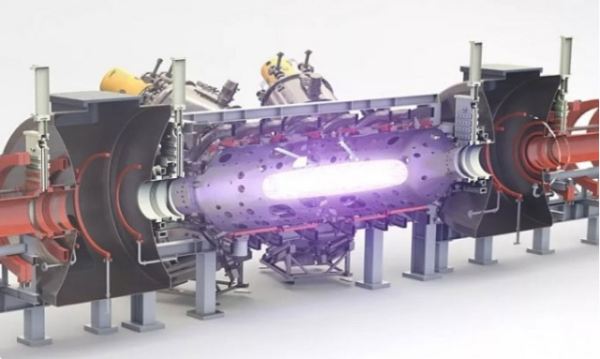In the realm of scientific breakthroughs, few discoveries have sparked as much excitement and intrigue as the development of nuclear fusion technology. Among the most remarkable advancements in this field is the creation of a fusion reactor that operates at temperatures a staggering five times hotter than the core of the Sun. This remarkable achievement marks a major milestone in humanity’s quest for sustainable, clean energy, offering the potential to revolutionize power generation worldwide. In this article, we will explore the fascinating details of this new fusion reactor, its significance, and what it means for the future of energy production.
Understanding Nuclear Fusion: A Game-Changer for Clean Energy
Nuclear fusion is the process that powers the Sun and stars, where atomic nuclei collide and fuse, releasing enormous amounts of energy. For decades, scientists have been working to replicate this process on Earth in a controlled environment. Achieving successful fusion reactions on Earth would provide a virtually limitless, clean, and safe energy source—free from the environmental and safety concerns associated with traditional nuclear fission or fossil fuels.
However, creating the conditions for nuclear fusion on Earth is no easy task. It requires temperatures and pressures so extreme that only the most sophisticated technologies can even begin to manage them. The new fusion reactor, which reaches temperatures five times hotter than the Sun’s core, brings us one step closer to this dream.

The Fusion Reactor’s Temperature: An Astonishing 75 Million °C
The core of the Sun is known to reach temperatures around 15 million °C. However, the recently developed fusion reactor in California operates at a staggering 75 million °C, making it five times hotter than the Sun’s core. This breakthrough in temperature management is made possible by advanced technology that controls and sustains high-energy hydrogen plasma.
At such high temperatures, the hydrogen atoms in the plasma achieve the necessary conditions to overcome their electrostatic repulsion and fuse. The resulting fusion reactions release vast amounts of energy, which can then be harnessed to generate electricity. The ability to achieve such high temperatures is a crucial factor in making nuclear fusion a viable source of energy for the future.
How Does the Fusion Reactor Work?
The fusion reactor developed by TAE Technologies, a leading innovator in fusion energy research, uses a cutting-edge approach to nuclear fusion. It employs magnetic confinement to contain and control the extremely hot plasma. The reactor uses powerful magnetic fields to keep the plasma stable and prevent it from coming into contact with the reactor walls, which would cause it to cool down and lose the necessary conditions for fusion to occur.
In this process, the reactor contains hydrogen isotopes—typically deuterium and tritium—which are heated to extreme temperatures. As these isotopes collide at high speed, they fuse into helium, releasing energy in the form of high-energy neutrons. The energy released can then be captured and converted into usable electricity.
TAE Technologies: Leading the Charge in Fusion Energy
TAE Technologies has been at the forefront of nuclear fusion research for many years. Their innovative approach to fusion energy involves a unique reactor design known as the Norman Fusion Reactor. This reactor represents a significant advancement in the field, achieving plasma temperatures far beyond previous milestones.
TAE Technologies has been working on refining their fusion reactor design for over a decade, continually improving its efficiency and ability to sustain high-temperature conditions. In fact, this breakthrough marks a major step forward, as it demonstrates the feasibility of achieving the necessary temperatures for controlled fusion on Earth.
The Role of Google and Other Industry Partners
One of the key factors in the success of the Norman Fusion Reactor is the collaboration between TAE Technologies and prominent industry partners, such as Google. Google’s involvement in the project began in 2014, providing both financial backing and access to cutting-edge technologies, including artificial intelligence (AI) and machine learning, to improve the reactor’s performance.
These technological advancements have proven to be invaluable, as they help to manage the complex processes involved in sustaining a plasma at such extreme temperatures. The fusion reactor relies on AI systems to monitor and control the behavior of the plasma, ensuring that it remains stable and conducive to fusion reactions.
The Future of Fusion Energy: The Copernicus Reactor
While the Norman Fusion Reactor has demonstrated remarkable success, TAE Technologies has already set its sights on the future. The next step in their fusion energy development is the Copernicus Reactor, which is expected to be even more efficient and capable of achieving even higher fusion performance.
The Copernicus Reactor aims to take the lessons learned from the Norman reactor and apply them to create a sustainable fusion energy solution that can be scaled up for commercial use. If successful, the Copernicus reactor could pave the way for the widespread adoption of fusion energy, providing the world with an abundant and environmentally friendly power source.
What Does This Mean for the Future of Energy?
The implications of this technological breakthrough are immense. If nuclear fusion can be successfully commercialized, it has the potential to transform the global energy landscape. Fusion energy offers several key advantages over current power generation methods:
- Sustainability: Fusion reactions use isotopes like deuterium and tritium, which are abundant and can be extracted from water and lithium. Unlike fossil fuels, fusion energy is virtually limitless and does not produce harmful emissions.
- Safety: Fusion reactions do not carry the same risks of nuclear accidents or long-lived radioactive waste as fission reactions do. The process is inherently safe, as any disruption in the fusion reaction will cause it to naturally cease.
- Efficiency: Fusion has the potential to generate far more energy than traditional methods, with far less waste. It can provide a nearly unlimited energy supply, which could meet the world’s energy demands for centuries to come.
- Environmental Impact: Fusion energy produces no greenhouse gases or harmful pollutants, making it a clean energy source that can help combat climate change.
Conclusion: A New Era in Energy Production
The creation of a fusion reactor that operates at temperatures five times hotter than the core of the Sun is a monumental achievement in the pursuit of clean, sustainable energy. With TAE Technologies leading the way and significant industry support, the dream of harnessing nuclear fusion to provide virtually unlimited energy is one step closer to becoming a reality.
As scientists and engineers continue to refine fusion reactor technology, we are entering a new era of energy production—one where fusion could become the cornerstone of the world’s energy infrastructure, powering homes, industries, and economies without harming the planet. This revolutionary development not only showcases the potential of fusion energy but also underscores the importance of continued research and investment in clean energy solutions for a brighter, more sustainable future.










